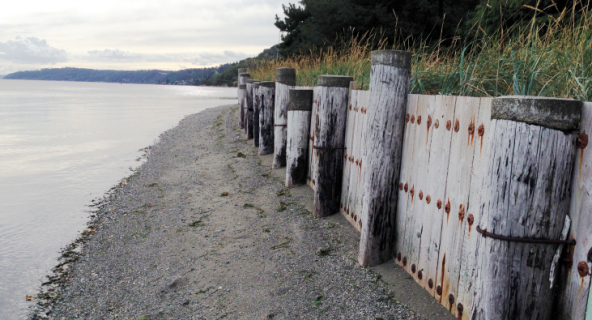There are more than 45,000 residential properties along Puget Sound’s shoreline. Of those, almost half have some form of environmentally damaging shoreline armoring. That makes private landowners a primary focus of state and federal armor removal efforts, but many landowners say they either lack funds or are unwilling to pay for sometimes costly beach restorations. Now, the Puget Sound Institute in collaboration with Coastal Geologic Services and Northern Economics is looking at ways to provide low-interest loans to homeowners for this purpose.
PSI and its partners will conduct a feasibility study for development of a revolving loan fund that would finance low-interest loans for residential shoreline projects like hard armor removal, soft-shore stabilization, and elevating or moving homes landward to reduce flooding risk as sea level rises. The project is led by PSI research scientist Aimee Kinney and receives Environmental Protection Agency funding through the state-run Habitat Strategic Initiative.
Kinney says the study was inspired by a revolving loan fund that was used to improve shorelines in Maryland along the Chesapeake Bay. As loans are paid back in that fund, the money is then lent out again in a continuous, revolving cycle.
“This is a common tool for environmental improvement projects,” Kinney says. “Revolving loan funds have been a successful way to incentivize people to invest in sometimes expensive projects. This study will look at whether a fund could work here.”
The study will focus on private property owners because experts believe that is where the most progress can be made. “Much of the damage to our shorelines occurred because of these small, residential armoring projects, so regional partners have been focusing restoration efforts on that same scale,“ Kinney says. More than 25% of Puget Sound’s shoreline is classified as “armored” with structures such as bulkheads and seawalls.
Shoreline armoring has been shown to hurt salmon and degrade beaches in Puget Sound, and several large armor removal projects on public shorelines have been completed. Programs such as Shore Friendly, a multi-agency outreach effort with funding from the Environmental Protection Agency turned the attention toward private landowners, and Kinney hopes the revolving loan fun can help support their work to catalyze the removal of seawalls all over the region. The study is expected to wrap up in late 2020.
You can read more about shoreline armoring on the Encyclopedia of Puget Sound.
— Jeff Rice, Puget Sound Institute
